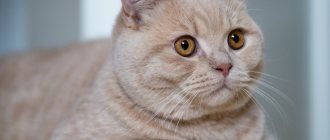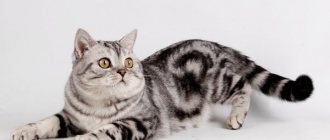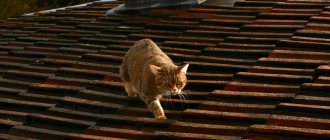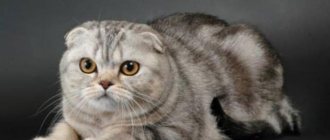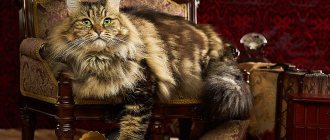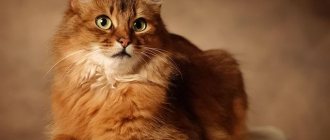History of chinchillas
The first smoky kitten was born in 1882 in England, as a result of an unplanned mating.
The parents of the baby, who was christened Chinni, were a mongrel cat and a blue Persian cat, who met by chance while walking. The owner of a Persian cat liked the kitten's non-standard color, which gave her the idea to start breeding a new breed. As a result, the already adult Chinni was crossed with a female cat, which had a striped-gray “fur coat”. The offspring born from a smoky mother and a tabby father did not inherit the unusual coat tone. However, a few years later, Chinni’s children began to bring unusual babies of the same chinchilla color, which felinologists around the world still do not stop arguing about. The first appearance of Chinni's descendants at exhibitions occurred in 1894 in London. After some time, American breeders also joined the experiments of Foggy Albion breeders, wishing to increase the palette of cat colors. This is how the golden (apricot) variety of chinchillas arose. Later, it became fashionable not only among Persians to form original colors, but also among representatives of other cat families. As a result, Scottish Folds and British dogs wearing silver and apricot “fur coats” began to appear more and more often at exhibitions.
Nutrition
A Scottish chinchilla cat should be fed in the same way as pets of other colors - with well-balanced food. As a rule, these include premium and holistic products that do not contain by-products and gluten. We are mainly talking about grain-free dry food. Or you can feed your pet natural food, but then you should carefully prepare a diet that should consist of meat, vegetables and dairy products.
Among the huge variety of domestic cat breeds, the Scottish chinchilla breed stands out. Its unusualness lies not only in its name, which is similar to the name of South American rodents, but also in its unique color.
Chinchilla cat standard
Chinchillas are solid and stocky cats. Their image is enhanced by their thick, dense coat, which gives their body a pleasant softness and roundness. Chinchilla cats are noticeably smaller than males, so the latter are always more popular among lovers of textured pets.
The chinchilla color is documented for representatives of three breeds:
- Persian;
- British (short-haired and long-haired);
- Scottish (straight and fold).
Individuals belonging to the Persian clan have longer fur and have super fluffy tails, the hair on which can be twice as long as on the body. The body standard of Persian chinchillas is the same as that of their eastern counterparts, but with minor additions. In particular, the noses of representatives of the first variety are not so short, so the problems of difficulty breathing, characteristic of brachycephalic breeds, are inherent to them to a lesser extent.
British chinchillas are large pets with round heads and chubby cheeks. Their eyes are wide apart, their ears are small with rounded tips, their noses are wide and short. Coat type: semi-long or short. In fact, all representatives of this branch differ from the traditional British only in color. All other characteristics are inherited by pets from their relatives in full. Typically, representatives of this type of chinchilla are silver or golden in color, but the latter option is less common.
Scottish “mix” chinchillas fully fit into the standard of Scottish folds and straights: the same slender legs, muscular body and raised pads on the face. The animals' fur is silver or peach with darkened tips. The hair itself is dense, short, but without a pronounced fit to the body. Acceptable iris colors for Scottish chinchillas are green and blue.
Colors of chinchilla cats
All three varieties of chinchillas have very complex color palettes. In general, we can say that animal fur comes in three basic shades:
- silver;
- golden;
- shaded.
Silver individuals are cats with white fur, which has a barely noticeable “spraying” of dark pigment at the very tip of the hair. No spots or extraneous patterns on the body are allowed, but it is imperative that the chest remain white. There are also veil and shaded varieties of silver color. In the first case, a dark “patina” on the wool creates the effect of a veil or organza, slightly darkening the light background of the “fur coat”.
An interesting fact: kittens with a veil color are born only when both parents are carriers of the same color.
Shaded Silver is a completely white undercoat and guard hair, ⅓ of which is dark in tone. The most intense colors of shaded chinchillas are the head, back, ears and tail. The collar area has a classic silver color, and completely dark hairs can appear on the paws and tail.
The palette of chinchilla veil and shading pigments is quite extensive. In particular, the tips of animal hairs can be colored in the following shades:
- chocolate;
- cinnamon;
- faun;
- blue;
- lilac;
- black.
An important nuance: chinchillas in veil-type “fur coats” with black hair pigmentation should have black eye rims bordered by white hair, as well as black paw pads.
The golden color of chinchillas is not identical to the red one. It's more of a soft apricot shade. Individuals with golden veiled “coats” are pets in which the pigment appears only at the very tip of the hair and only in certain areas. The most pigmented parts of the body are the back, ears, head, and tail. On the sides the “veil” noticeably thins and completely disappears closer to the stomach. The shaded golden coat is colored in dark tones for ⅓ of its length. More intensely pigmented areas are the back and head of the animal. The collar area remains white.
Scottish chinchilla golden ticked kittens
What do golden chinchilla kittens look like and how to choose such a kitten.
Recently, a bright new color has appeared in the Scottish Fold breed - this is the golden ticked color. Very often this color is mistakenly called “golden chinchilla”
The golden ticked color came to our breed from British cats. Golden ticked kittens have a special charm. They look like ginger kittens, but unlike ginger kittens, they have bright green emerald eyes and a black tail tip. These kittens also have black heels and black elbows.
If you carefully examine the individual hairs of such a kitten’s fur, you will see an alternation of wide apricot stripes and thin black stripes on each individual hair.
At the same time, in general, a golden ticked kitten looks painted in one apricot color.
Only such a kitten will always have a beautiful pattern in the shape of the letter M on its forehead.
In the pedigree this color is numbered as NY 25
The golden chinchilla is the rarest of the golden colors. In such animals, the amount of black on the hair is so small that it is practically unnoticeable. On each individual hair of such a cat there will be no more than 1/12 black at the very tip of the hair. Usually black can only be seen with a magnifying glass. In the pedigree, this color is numbered as NY 12. Such kittens are born very rarely and the cost of such a kitten is usually several times higher than the cost of a golden ticked one.
Therefore, golden ticked kittens are often sold as golden chinchillas. It sounds very nice, but unfortunately, it is not entirely fair to the buyer.
However, there is another common color that is also passed off as a golden chinchilla - golden shaded.
Such an animal has a residual pattern on the body, because 1/6 of the hair is dyed black, and not 1/12, like the golden chinchilla. But in general, such a kitten will be a bright apricot color, lighter than golden ticked, but slightly darker than golden chinchilla. In the pedigree this color is numbered as NY 11.
In the nurseries of our association, kittens of all three colors described above are born.
Source
Character of a chinchilla cat
Since we are talking about three different breeds, united by a common shade of coat, it is logical to assume that the characters of their representatives will differ. Chinchillas also have individual behavioral characteristics that allow them to stand out from the rest of their fellow tribesmen. In general, it is worth noting that the unique color muted the wild instincts of the breeds, so most cats with silver and golden fur remain very cute and obedient pets.
Persian chinchillas are calm and incredibly gentle creatures. Breeders speak of them as super-patient pets, completely devoid of the arrogance and desire for independence inherent in cats. In fact, the chinchilla Persian is a born “couch dweller” and “cushion crusher”, addicted to comfort and stubbornly unwilling to part with his comfortable addiction. Persochinchillas do not annoy you by meowing. The breed's voice is quiet, almost inaudible, so sometimes it is difficult to understand what exactly the animal wants. Chinchillas are not too happy to be around other, more active pets, but they steadfastly tolerate children's pranks, even if they frankly do not like them.
British chinchilla cats are softer in character than their relatives, who have standard coat tones. They are less independent and willful, and in general they have a calmer temperament. In addition, chinchilla cats are neutral towards stroking and hugging, which the British do not like. You shouldn’t expect any manifestations of aggression or obstinacy from the breed either. By the way, British chinchillas are one of those rare types of pets that feel equally good both close to their owner and completely alone. These teddy bears will easily endure your visit or supermarket, without jumping on cabinets and window sills and without announcing their forced seclusion with annoying meows.
Scottish chinchillas are the same good-natured phlegmatic people as all Scottish dogs. They are a little less persistent in achieving their goals than classic folds and straights, but to a large extent they have inherited the habits of their fellow tribesmen. The breed’s human orientation is also a little more developed, so in ordinary life its representatives are easier to train. The pride characteristic of the Scots is not so pronounced in their descendants, so the animals are ready to dissolve in their owner, performing the function of a living anti-stress toy. The voice of Scottish chinchilla cats is as quiet and creaky as that of other representatives of the breed, but cats use it in the most emergency situations, preferring meaningful silence and philosophical contemplation of the surrounding situation to conversations.
Reviews
All chinchilla owners speak highly of them; they are a sophisticated and wonderful breed that gets along well with children and brings a lot of pleasure to their owners.
These beauties move gracefully, rarely annoy people and rarely raise their voices. They like to sit next to the family when its members get together, for example, while watching TV.
The four-legged animals also look at the screen and watch the actions taking place there. They have an independent character and need privacy from time to time, but they also love to communicate.
Education and training
Chinchillas need to be raised and trained using the same methods as all cats, but taking into account the individual characteristics of each breed. Mandatory skills and abilities that the animal must master by the age of one year:
- the ability to respond to one’s own nickname;
- go to the toilet and sharpen your claws in a strictly designated place;
- observe the sleeping and feeding schedule, do not wake the owner at night;
- sit calmly in the owner's arms;
- adequately perceive the need for transportation: traveling in a carrier bag, traveling by car.
Owners of show pets will also have to work on the technique of displaying the animal at an exhibition. Since both the British, the Persians, and the Scottish have a compact body, in the ring they are not exhibited “stretched” like Orientals, but in a grouped state. Preparation for this action is considered to be the development in the cat of the habit of sitting on the laps and hands of the owner, as well as patiently accepting changes in posture at the insistence of the person.
Persian chinchillas are intelligent and highly intelligent cats, grasping basic cat wisdom on the fly. For example, by 1-1.5 months, kittens go to the litter tray quite carefully. Often, if babies live with their mother or another adult cat, they don’t even need to be taught this skill - the furballs independently copy the behavior of the older pet.
Young and even slightly mature chinchillopers retain a lively interest and curiosity in things they see for the first time, so at first you will have to hide indoor plants, toxic detergents and cleaners, as well as the wires of household appliances from the animal. The breed does not produce any destructive actions - chinchillas do not scratch furniture (provided that there is a normal scratching post in the house), they do not rummage through the owner’s plates, and they do not take away piece by piece a newspaper forgotten by the bed.
At the beginning of socialization, it is important for a kitten in a new home to create a peaceful atmosphere, so try to make less noise in the presence of the baby and warn your household about this. Classes should be carried out taking into account the chinchilla’s biorhythms: in the mornings and afternoons, cats are inactive and prefer to take a nap. And of course, keep in mind that not a single pet is capable of multitasking, so if you decide to practice one command, finish what you started without switching to teaching your furry other useful skills.
Chinchillas from the British and Scottish clans are hampered in their studies by natural shyness and timidity. These comrades are generally frightened by everything new and unknown, so during lessons, talk more with your pet in an even, calm voice. A chinchilla doing dirty tricks is such a rare phenomenon that not every owner of the breed manages to see it. If, nevertheless, the pet is drawn to the “scratchers” or the dining table, influence the animal with its own fears. Suddenly clap your hands or secretly splash water on the furry criminal - then you can only watch how the chinchilla coward quickly runs away from the crime scene, turning into a quiet good boy.
Maintenance and care
Like any decorative pets, chinchillas need to be provided with maximum comfort in the apartment, outside of which they very rarely go. Take care of safety: if you decide to walk your cat on the loggia, do not forget to close the windows or cover open window openings with netting. Chinchillas, British and Scottish dogs are not the most jumping creatures, but sometimes they want to frolic too, so buy your animal at least a small play set. A cozy bed or basket is also necessary - representatives of this clan are comfort-dependent and love soft mattresses.
Hygiene
Owners of Persian chinchillas will have to put in the most effort. Adults should be washed at least once a month, and kittens every two weeks. In addition, you will have to spend time searching for special shampoo and balm. Do you want to preserve the exquisite color of your cat’s “fur coat”? Look for cosmetics formulated for animals with light fur. Systematic scratching also cannot be avoided, so if you don’t want to devote a lot of time to the image of your pet, pay attention to chinchillas from the British and Scottish genus. There is much less fuss with their wool.
British chinchillas are washed only when they are really dirty. In other cases, you can get by with collecting dead hairs with a damp cloth or rubber glove. A little more work with representatives of the semi-longhaired variety of the breed. These comrades will have to be fully combed, and during periods of seasonal molting they will even have to be treated with a furminator.
Care for the eyes and ears of chinchillas of all breeds is standard. The organs of vision are examined daily, the ear funnels are examined once a week. Mucous lumps in the corners of the eyelids are removed with a clean cloth, which can be moistened in cold boiled water or chamomile infusion. Do not forget that both the Persians and the British are characterized by excessive tearfulness. Usually tear tracks leave unsightly marks on the silver fur, so to keep your pet looking perfect, wipe away tears often and buy a special lightening powder for the area around the eyes.
It’s great if you have trained your chinchilla to adequately accept brushing its teeth with a classic brush. If you can't get your pet to use this device, consider alternatives: solid treats that remove plaque, as well as oral lotions like Cliny, which are added to drinking water.
Feeding
There is no consensus on how to properly feed a chinchilla kitten. Most nurseries give preference to high-quality dry food with a high protein content and a minimal percentage of grains. Typically, such varieties are completely balanced, so all that is required from the owner is to measure out the correct portion to the animal, which will satiate, but will not cause excess weight gain. Another advantage of “drying” is that the animals that eat it do not need to brush their teeth, since dry croquettes perfectly “erase” any type of plaque.
Veterinarians continue to “vote” for natural products: lean meat and offal, low-fat fermented milk, fish fillet, vegetables (except legumes and potatoes) and fruits. Bakery products, any food from the master's table and meat delicacies intended for people are strictly prohibited. At the same time, it is important to understand that it is difficult to balance the diet with food alone, so from time to time you will have to grow grass for your pet on the windowsill, buy dietary supplements with taurine, as well as vitamins for the beauty of the coat. By the way, about supplements: at different ages, chinchillas need certain dietary supplements. If kittens need complexes with a large amount of minerals, then older individuals need vitamin D, calcium and phosphorus.
Appearance care
Complete care for the appearance of a British chinchilla consists of several activities that should be carried out strictly.
Combing
The coat of golden chinchillas includes guard hair and undercoat. Such a multi-level cover needs careful care. Combing is carried out first in the direction of hair growth, and then against the grain. This procedure is performed twice a week, using a special glove or a fine-toothed comb.
Bathing
Despite the fact that the coat of golden chinchillas is quite light, it does not get dirty very often. Therefore, there is no need to bathe your pet often - once every 3 months is enough.
For washing, special shampoos and softening conditioners are used. If there is an urgent need, you can use dry products for washing cat fur, which are selected taking into account the color of the pet.
Ear care
Chinchillas' hearing organs should be carefully examined every 2 weeks. Ear care involves removing dirt and dark plaque using cotton wool. The latter should be moistened with a special composition intended for caring for the ears of cats.
Chinchilla health and diseases
The main problems of Persian chinchillas are uncontrollable lacrimation and susceptibility to colds. The latter phenomenon is directly related to the structural features of the animal’s skull. All chinchillopers have been diagnosed with a slight curvature of the nasal septum, due to which even a slight runny nose is more difficult for them than for other cats.
British and Scottish Straight chinchillas do not have genetic diseases. At the same time, representatives of these families easily catch various infections, the salvation from which will be timely vaccination. Cats are also prone to gaining extra pounds, so when creating a diet, you will have to constantly keep your finger on the pulse.
Scottish Fold chinchillas are not as big as Straights. In particular, Scottish Folds exhibit a genetic disease such as osteochondrodysplasia. The disease is provoked by the gene responsible for the drooping shape of the animal’s ear, so it will not be possible to prevent it even if one wants to.
Scottish fold chinchilla: description of the breed, colors, reviews
The Scottish cat of the chinchilla color has become so popular and recognizable today that felinologists even considered it possible to designate this particular color as a separate breed line.
Its peculiarity is not only in its name, which is consonant with South American rodents, valued for their luxurious fur, but also in its color - the coat of these cats is light gray with a delicate bluish tint. Although breeders have achieved some other shade options. So, meet the Scottish fold chinchilla cat. In the article we will talk about the characteristics and standard of the breed, as well as some of the subtleties of its maintenance.
How to choose a kitten
- Kittens of corpulent breeds such as British and Scottish cats grow very unevenly. Accordingly, when going to the nursery, calmly accept the fact that two-month-old babies look extremely cute, but six-month-old teenagers have a very unsightly appearance.
- When buying a Scottish Fold chinchilla, conduct a thorough inspection of its limbs. If a kitten has too short legs and a tail, these are signs of impending osteochondrodysplasia.
- Many chinchilla colors are unstable and can change the saturation of the tone, so if you are afraid to miss, choose cats over the age of 1 year.
- Be sure to meet the kittens' mother. If the breeder stubbornly hides the female breeder, this is a reason not to conclude a deal. You should also not take babies who, for some reason, were raised not by the cat, but by the breeder himself - kittens that did not feed on mother's milk in the first month of life have weak immunity and run the risk of contracting an infectious disease.
- Assess the condition of the animal's coat. A purebred chinchilla should not have bald spots or areas with sparse hair.
Price
If you decide to buy a kitten, it is better to do it in a large nursery, this way you will definitely protect yourself from deception. In addition, the seller will continue to advise you regarding care and maintenance. The cost depends on the class, there are three in total.
A pet, usually purchased only for the soul, will cost you about thirty thousand rubles. Such individuals do not have a stellar career, but they are just as sweet and attractive as others, they just have deviations from the standard.
Breed, any representative of which can participate in exhibitions, costs approximately fifty thousand.
Show - the cats belonging to it are descendants of medalists and will definitely win awards in various competitions. They have a price of about seventy thousand.
